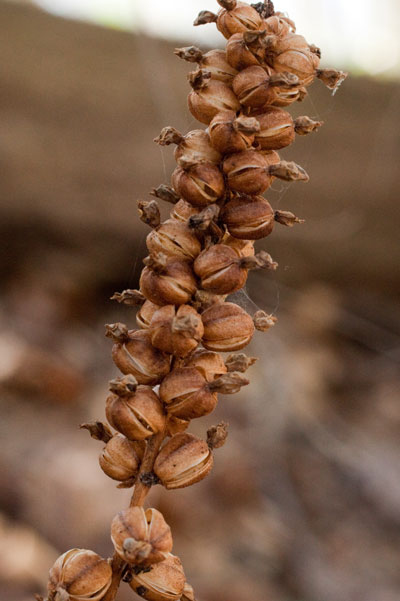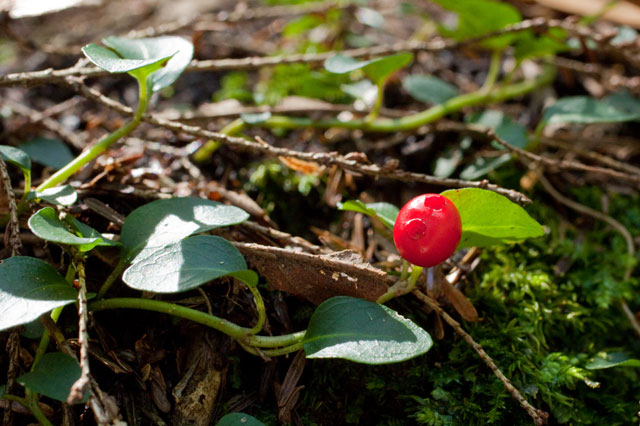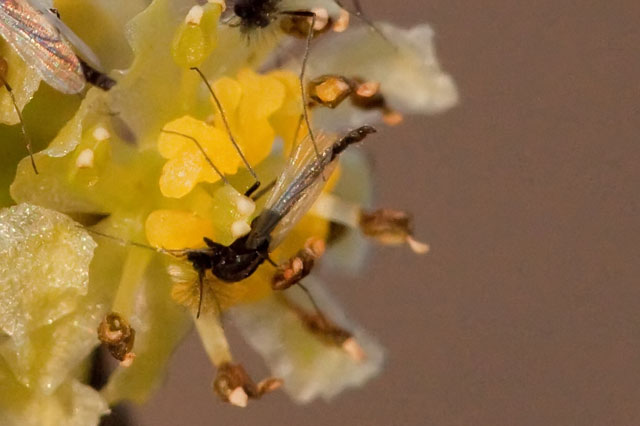 |
 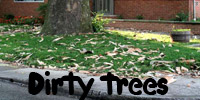 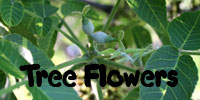 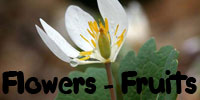 |
Welcome
to bobklips.com, the website of Bob Klips, a plant enthusiast living in
Columbus, Ohio. False mermaid weed: a very good mother! Delaware Wildlife Area Delaware County, Ohio. April 26, 2009 Traits that pertain to
an organism's
schedule of reproduction and death make up its "life history." Life
history traits include the age at which an organism
first
reproduces, how often it does so, how many offspring it has,
and
the amount of parental care each offspring receives.
The tradeoff between the number of offspring and the resources
available for each one has led ecologists to distinguish two
sharply different patterns, called "r-selection" and "K-selection."
(The names are derived from a population growth equation where "r"
concerns the rate of reproduction and "K" is the limit to population
size set by the environment.)
A trio of trilliumsTypically, r-selected plants are small, fast-growing, short-lived things that bear a large number of small fruits, i.e., weeds of open disturbed sites. K-selected plants are generally large-bodied, long-lived species with big fruits, i.e., forest trees. An interesting departure from the "annuals are r-selected" pattern is exhibited by some forest annuals. There aren't very many forest annuals, as the shady environment is a difficult place to grow from seed to grown-up plant in a single season. One incredibly abundant forest annual is false mermaid, Floerkea proserpinacoides (family Limnanthaceae). It grows as swarms of individual delicate stems on the ground in moist woods, each bearing a few flowers. The pistil of each flower has two or three chambers, each of which can produce one seed. The plant shown here, a robust individual, seems to have 5 or 6 flowers. Translating to a total lifetime seed output of roughly 12 seeds, this annual is remarkably K-selected. Can you think of any other plant that has so few "kids," and thus such high seed survivorship? 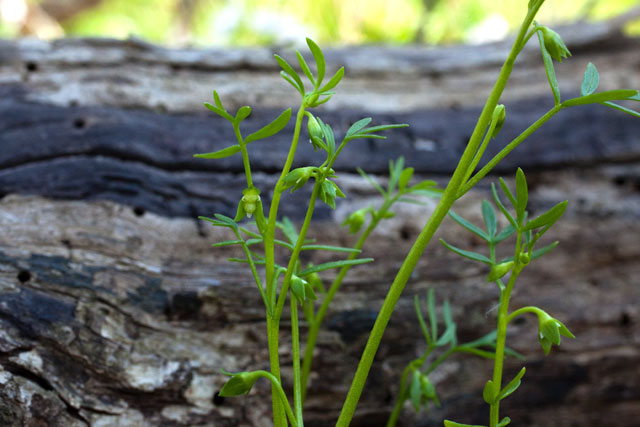 False mermaid. April 26, 2009. Delaware (Ohio) Wildlife Area. Delaware Wildlife Area Delaware County, Ohio. April 26, 2009 Every year about this
time, several good
friends get together for their annual "wildlfower walk" in woods at the
Delaware Wildlife Area alongside Alum Creek. It was a good
year
for trillium, as this year we had a sighting of an uncommon
one
that is sometimes missed --"drooping trillium," Trillium
flexipes. Yay!
Trillium is a member of that most typical monocot family, the Liliaceae (Lily family), distinguished by having showy flowers with their parts in threes: 3 sepals, 3 petals, 6 (2 x 3) stamens, and a pistil made up of 3 parts (carpels) fused together. Trillium differs from our other lily family members in that their sepals are actually green and sepal-like instead of being brightly colored just like the petals. There are 4 trillium species in central Ohio --the uncommon, very early-flowering snow trillium (T. nivale) that occurs in some woodlands flanking the Scioto River, and these 3 we saw today: "Toadshade" (T. sessile) is recognized by its mottled leaves and unstalked (sessile) flower that doesn't ever open widely. Toadshade flowers are foul-scented, attracting beetles and flies as pollinators. 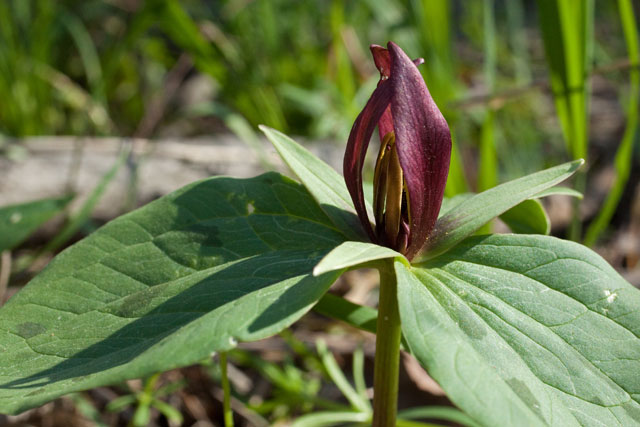 Toadshade at Delaware (Ohio) Wildlife Area April 26, 2009. The large-flowered
trillium, T. grandiflorum,
is a widespread, sometimes abundant wildflower that is well loved by
people and, unfortunately, by deer. Deer exert a detrimental
influence
on forest understory vegetation. (Is there a more succinct way to say
that?) This flower is used in the logo for the Ohio Byway program. Cute
logo!
 Ohio Byway logo. The logo could be
labelled "autotroph," as
it shows (white) an organism that uses energy from (yellow) the
sun to combine
gases in (blue) the air and minerals in (green) the
ground to construct
itself. Below, see large-flowered
trillium doing just that.
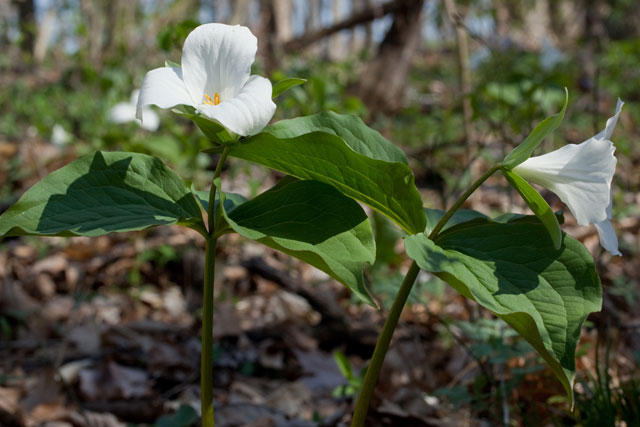 Large-flowered trillium at Delaware (Ohio) Wildlife Area. April 26, 2009. Here's the drooping
trillium, T. flexipes. (This is often mistaken for
"nodding trillium," T. cernuum, a northeastern
species collected only once in Ohio, from Lake County in
1879.)
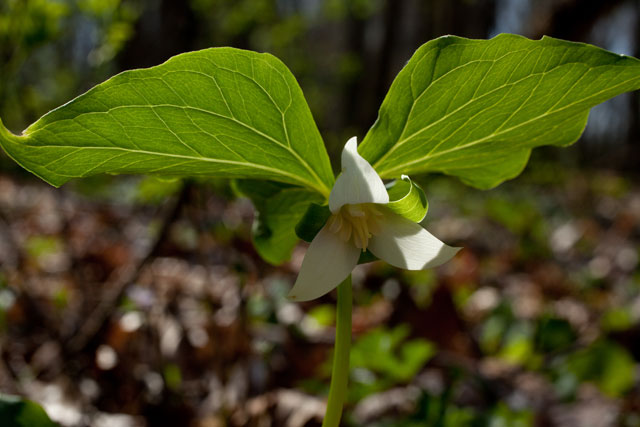 Drooping trillium. Delaware Wildlife (Ohio) Area. April 26, 2009. There are many more
plants in this woodland trying to pass their genes on to future
generations. Among them is Dutchman's
breeches (Dicentra
cucullaria, family Fumariaceae), pollinated by
bumblebees.
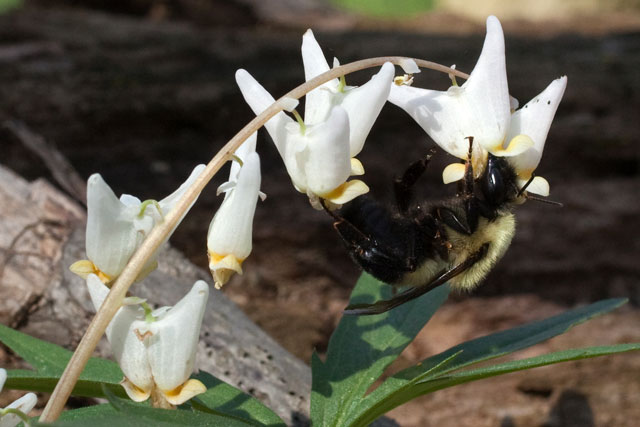 Bumblebee foraging on Dutchman's breeches. April 26, 2009. Delaware (Ohio) Wildlife Area. Here's a video of this
bee actively at work. Bumblebees overwinter as mated queens. In early
spring, a queen establishes an small colony shallowly
underground,
typically in an old mouse tunnels or nests. She builds wax chambers for
her brood, and feeds the larvae pollen and nectar gathered from a great
variety of flowers.
Bumblebee foraging on
Dicentra at Delaware Wildlife Area. April 26,
2009.
Spring-beauty (Claytonia virginica, family Portulacaceae) is a small and abundant wildflower. It bears lance-shaped opposite leaves and five-petaled flowers. In an interesting departure fronm the common floral pattern wherein the number of sepals is the same as, or a multiple of the number of petals, flowers in this family have only 2 sepals (visible on the drooping old blossom at bottom of photo). 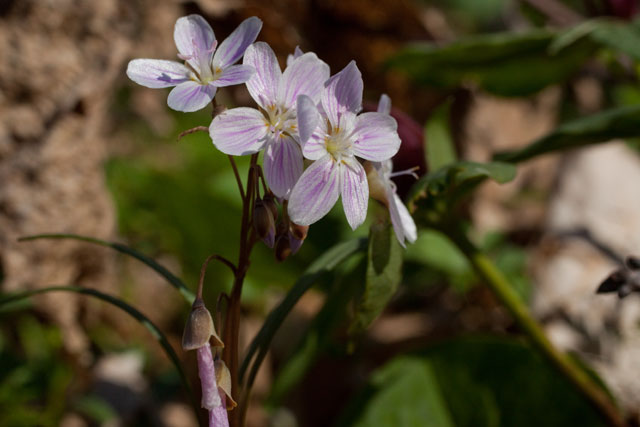 Spring-beauty.
Delaware (Ohio) Wildlife Area. April 25, 2009.
Spring-beauty is one of the few native wildflowers that is also a weed! It is abundant in lawns and grassy roadsides in central Ohio, as shown below in the Clintonville neighborhood of Columbus. Spring-beauty spreads by undergound tubers (said to be edible). Perhaps this accounts for its success in a habitat where pollinators and sites for seedling establishment may be scarce. 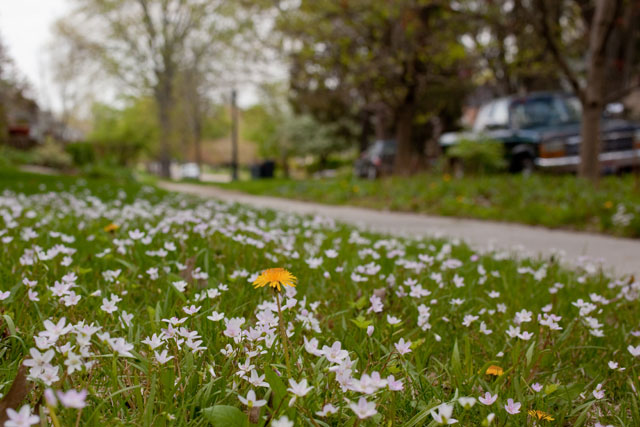 Spring-beauty in the city. April 26, 2009. Columbus, Ohio. Some people like to
rescue animals that
have been smacked by cars, bitten by cats, etc. But the wildflower
walkers instead focus their altruism on plants in
trouble. Although
looking like a suave Frenchman or a 1960's Greenwich Village beatnik,
this poor
spotted geranium leaf was trapped inside an acorn cap, struggling to
extricate itself. Intrepid heroes saved the day.
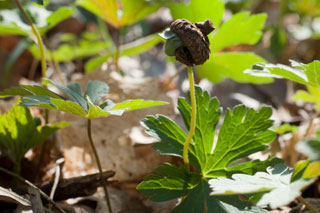 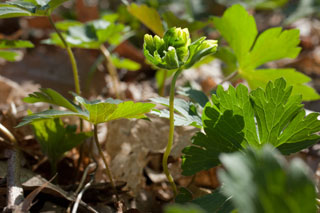 Spotted geranium leaf
before (left) and after (right) brave rescue!
This weekend I had the
great pleasure of joining members and friends of the Ohio Environmental
Council on a wildflower hike at the Lake Katharine State Nature
Preserve in Jackson County, Ohio. This was part of their "Real Ohio"
tour series exploring some of the State's finest natural areas. It was
great fun
meeting terrific people and seeing lovely spring wildflowers. Also, we
were
reminded of some threats to Ohio biodiversity. The preserve has one or
more deer exlosures that dramatically demonstrate their
influence on the forest understory vegetation. The following is a sober
and well-reasoned narrative that describes Odocoilius
virginianus with respect to the vegetation.
A
picture (MOUSEVER the essay) is worth (count 'em!) a thousand words.
Deer
exclosure with a trillion trilliums inside.
Lake
Katharine State Nature Preserve. April 25, 2009.
Despite the best
efforts of deer to use them as cellular fuel and raw materials
with which to build their own bodies (darn those heterotrophs!), there
are still some great spring wildflowers blooming. Violets are among
them. Of Ohio's 23 native species of Viola (family
Violaceae), nearly half of them (10 species) are not violet or
even blue, but have yellow or white flowers. Violets are subdivided
into "stemmed" species that bear leafy stems bearing axillary flowers,
and "stemless" ones with their leaves all basal and flowers
one by
one on leafless scapes among the leaves. Sweet while violet (Viola
blanda)
is a stemless violet, a denizen of cool ravines and moist shady slopes,
often found in the shade of evergreens such as eastern
hemlock, common at Lake Katharine.
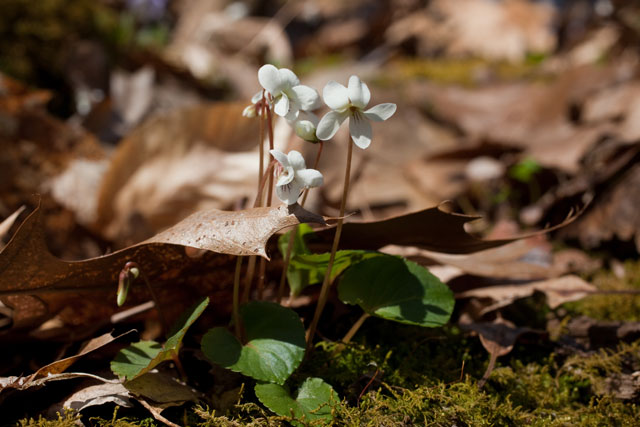 Sweet white violet. Lake Katharine State Nature Preserve. April 25, 2009. Other understory herbs
that caught our attention are not in bloom yet this year, but are
consicuous nonetheless. Downy rattlesnake-plantain, Goodyera
pubescens (family Orchidaceae) is striking by its foliage
alone,
consisting of a cluster of basal leaves smartly reticulated with
white.
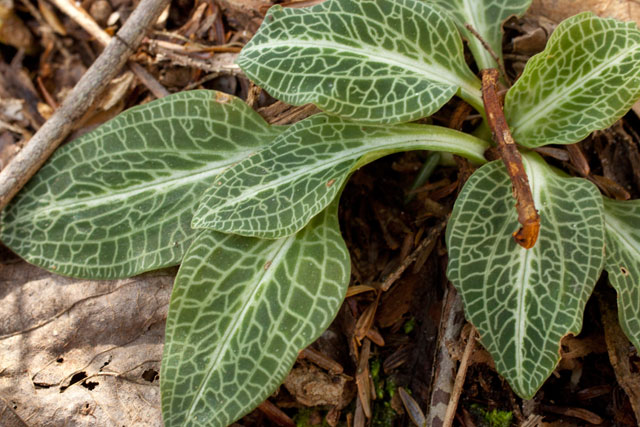 Downy
rattlesnake-plantain. April 25, 2009. Lake Katharine State Nature
Preserve.
Some of the
rattlesnake-plantains bear persistent elongate fruiting spikes. The
fruits are dry capsules abundantly filled with seeds that are super
very extremely tiny because, like all orchids, they totaly lack
endosperm or any other stored food for the germinating
seedling.
The baby plants depend upon mychorhizal
(root-associated) fungi for nutrition. These plants flower in
mid-August. Please consider mouseovering, or mousingover, or
overmousing the image to see the species in flower a few years ago at
Deep
Woods Preserve, Hocking County.
MOUSEOVER the image
to see flowers
MOUSEOVER the image
to see flowers
Downy
rattlesnake-plantain fruits.
Lake Katharine State Nature Preserve. April 25, 2009. Another interesting wildfruit is partridge-berry, Mitchella repens (family Rubiaceae). On this evergreen vine the flowers are borne in pairs, and the fruit is a twin berry composed of the ripened ovaries of two flowers. The berry is said to be "edible but insipid." Musover to see the species in flower, mid-June last year at Deep Woods Preserve, Hocking County. It has hairy petals! MOUSEOVER the image
to see flowers
MOUSEOVER the image
to see flowers
Partridge-berry at Lake
Katharine State Nature Preserve, April 25,
2009.
Spleenworts
(Asplenium)
Lake
Katharine State Nature Preserve
Jackson
County, Ohio, April 25, 2009
The
fern genus Asplenium (name from
the Greek, a-without, and splen, spleen, in reference to supposed
medicinal properties) comprises the spleenworts. These are delicate
evergreen ferns, many of which grow on cliffs such as this sandstone
one at Lake Katharine State Nature Preserve in Jackson County, Ohio.
Here we see two plants: the lower one is small and lacy-leaved, while
the upper one is slightly larger, less disssected, with more nearly
entire pinnae.
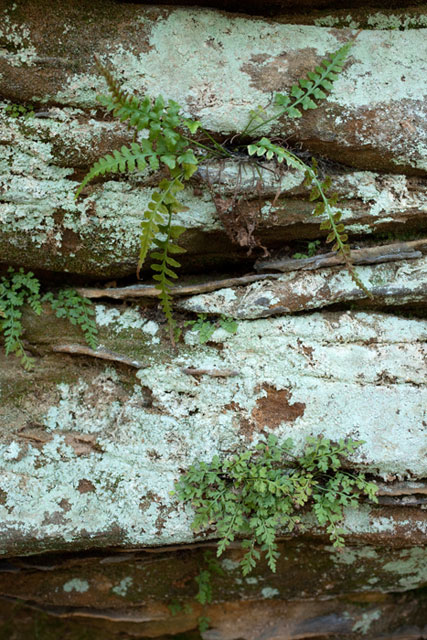 Spleenworts. April 25, 2009. Jackson County, Ohio. Another
spleenwort
feature is the linear shape of the indusia (spore-case
clusters) and their location alongside lateral veins onthe undersides
of the leaves.
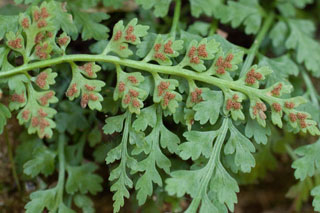 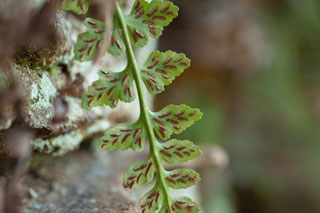 Spleenwort
indusia.
Left: Asplenium montanum. Right: Asplenium
x. trudellii.
April
25, 2009. Lake
Katharine State Nature Preserve.
The
lacy lower
one is a clear example of mountain
spleenwort, Asplenium montanum, distintinctive
in a technical/diagnostic sense by its laciness as species
diagnostic traits include leaves that are completely
divided into
leaflets (it is "pinnate") with the leaflets (pinnae) themselves
deeply and irregularly lobed. The acidic (sandstone) rock ledge habitat
is
correct also. 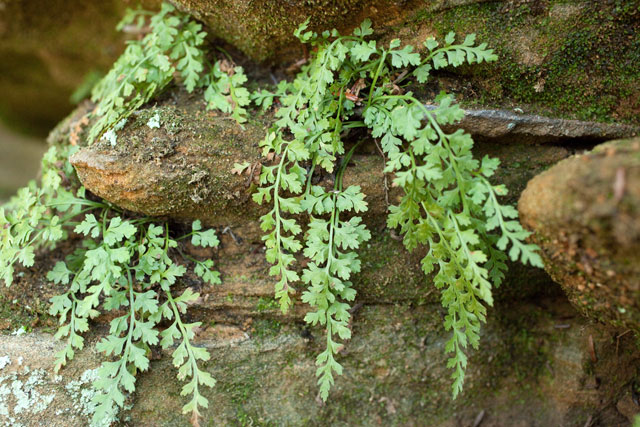 Mountain spleenwort. Lake Katharine State Natre Preserve, April 25, 2009. The
less lacy upper
one, which started out
to be a bit of a mystery (eventually solved) is pinnate, at least in
the lower half, but the pinnae (leaflets) are not quite divided
completely into separate sub-leaflets (pinnules) as they are in its
lacy ledge-mate.
Accordingly it somewhat resembles a plant named Asplenium
pinnatifidum (lobed spleenwort), but comparison with
illustrations and descriptions in the terrific new Peterson Ferns
field guide showed the leaflets of this Lake Katharine specimen to be a
smidge too wavy-edged to the be that "species."
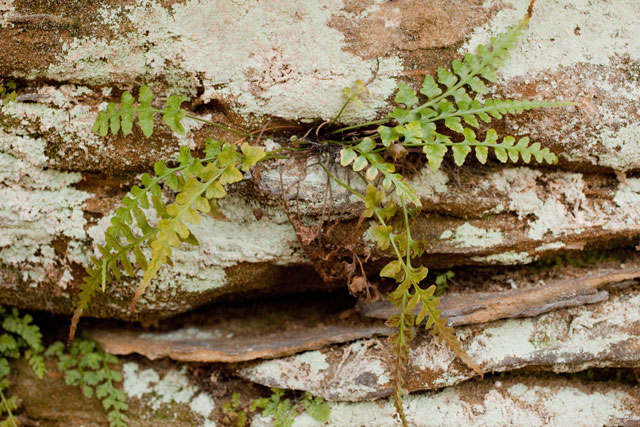 Mystery
fern that
turned out to be Trudell's spleenwort, a backcross!
The word "species" is in quotation marks above because the A. pinnatifidum (lobed spleenwort) is a hybrid. Spleenworts are famous for freely interbreeding with one another. Numerous hybrid forms have been recognized and in some cases designated as species. This is explained very well in the terrific new Peterson Field Guide Ferns of the Northeastern and Central North America, 2nd Edition, by Cobb, Farnsworth and Lowe, published 2005 by Houghton Mifflin. The guide explains that 8 of the spleenworts in our area are non-hybrid "parental taxa" between which there is a network of interbreeding. Above the Asplenium key the guide has a great diagram, shown below, wherein the large filled hybrid circles represent fertile hybrid taxa and the open ones are sterile. (The small circles represent hybrids that don't occur in the area covered by the guide.) Lobed spleenwort is a hybrid between (lacy-leaved) mountain spleetwort and the completely undivided "walking fern," A. rhizophyllum. Puzzled about this what this mysterious fern might be, I sent these Lake Katharine pics to Brian Gara, a botanist friend who knows a lot about ferns. Brian promptly explained it is Trudell's spleenwort (A. x trudellii, wherein the "x" signifies its hybrid status), the result of a cross between mountain spleenwort and lobed spleenwort, the latter "probably hiding somewhere in the rock crevices." Wow! Inasmuch as lobed spleenwort is itself a hybrid, and one it its parental taxa is mountain spleenwort, this is an instance of "backcrossing." Hybridization followed by backcrossing is one of the ways that genetic variation can be introduced into populations. Below, the Asplenium hybridization diagram from the Peterson guide, with Trudell's spleenwort sketched in. 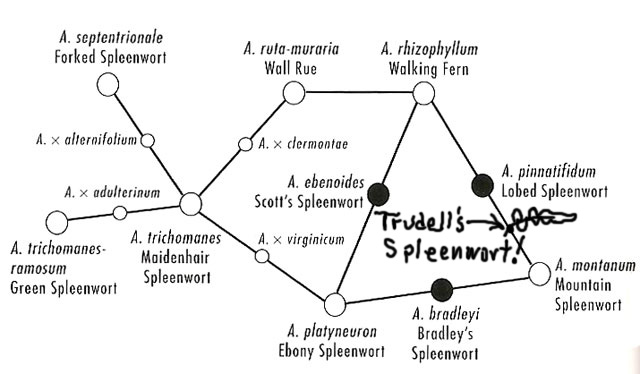 Network
of
spleenwort hybrids as shown in Peterson Ferns
Field Guide (2005).
A
metaphor plant
Pussytoes (Antennaria) Jackson County, Ohio, April 25, 2009 Many
plants
have fanciful common
names based on a resemblance to objects, parts of animals, people, etc.
What fun! Here are some such "metaphor plants," gleaned from the
indexes of a few field guides.
Some
metaphoric names of plants of the northeastern U.S.
adam-and-eve
(Aplectrum
hyemale);
adam's needle (Yucca filamentosa); adder's mouth (Malaxis);
adder's tongue (Ophioglossum vulgatum); arrow-head (Sagittaria);
bachelor's button (Centaurea);
beard-tongue (Penstemon); beggar-ticks (Bidens);
beggar's lice (Hackelia); black-eyed susan (Rudbeckia);
blazing-star (Liatris); bleeding-heart (Dicentra);
blue flag (Iris); blue-bottle (Muscari
racemosum); blue-eyed mary (Collinsia verna);
bluebell (Campanula); bouncing Bet (Saponaria);
bugle (Ajuga); butter-and-eggs (Linaria
vulgaris); cat-tail (Typha); cat's-ear (Hypochaeris);
cleavers (Galium); coltsfoot (Tussilago);
coontail (Ceratophyllum); crane's-bill (Geranium);
crowfoot (Ranunculus); devil's club (Opplopanax
horridum); dragon's mouth (Arethusa bulbosa);
false dragonhead (Dracocephalum);
Dutchman's breeches (Dicentra cucullaria);
Dutchman's pipe (Asarum); elephant's foot (Elephantopus);
foxtail (Setaria); goat's-beard (Tragopogon);
Hercules' club (Aralia spinosa); horsetail (Equisetum);
hound's-tongue (Cynoglossum officinale);
jack-in-the-pulpit (Arisaema triphyllum);
Jacob's ladder (Polemonium) lady-slipper (Cypripedium);
lizard's-tail (Sauruus cernuus);
maidenhair (Adiantum); moneywort (Lysimachia
nummularia); mist-flower (Eupatorium coelestinum);
monkey-flower (Mimulus); moonseed (Menispermum);
miterwort (Mitella); monkshood (Aconitum);
Indian-pipe (Monotropa uniflora); mouse-tail (Myosurus);
ox-eye (Heliopsis); pipe-vine (Aristolochia);
prince's feather (Polygonum orientale and Amaranthus
hybridus); pussy-toes (Antennaria plantaginifolia);
rocket, dames (Hesperis matronalis);
shepherd's purse (Capsella bursa-pastoris);
shooting-star (Dodecatheon media); silverbell-tree (Halesia
carolina); skullcap (Scutellaria);
snow-on-the-mountain (Euphorbia marginata);
squirreltail (Hordeum jubatum); star-of-Bethlehem (Ornithogalum
umbellatum); star grass (Aletris
and Hypoxis); star-flower (Trientalis
borealis); stork's-bill (Erodium cicutarium);
sundew (Drosera); sundrops (Oenothera);
sunflower (Helianthus); tape grass (Vallisneria
americana); thimbleberry (Rubus parviflora);
tickseed (Coreopsis); turkey-beard (Xerophyllum);
turkey-foot (Andropogon gerardii);
turtlehead (Chelone glabra);
velvet-leaf (Abutilon theophrasti); Venus'
comb (Scandix pecten-veneris); Venus'
looking-glass (Specularia perfoliata);
green dragon (Arisaema dracontium); bird's eye (Veronica
persica); bird's-foot trefoil (Lotus corniculatus);
bird's-nest (Daucus carota); giant bird's-nest (Pterospora
andromedea); bloodroot (Sanguinaria canadensis);
bursting heart (Euonymus americana); buttercup (Ranunculus);
butterfly-pea (Clitoria mariana); catfoot (Gnaphalium
obtusifolium); cheeses (Malva neglecta);
corpse plant (Monotropa uniflora);
cranefly orchis (Tipulara); crownvetch (Coronilla
varia); cup plant or Indian cup (Silphium
perfoliatum); devil's paintbrush (Hieracium
auriantiacum); dewdrop (Dalibarda repens);
devil's bit (Chamaelirium luteum); fairy wand (Chamaelirium luteum);
doll's eyes (Actea pachypoda); fairy bells (Disporum
lanuginosum); false mermaid (Floerkia
proserpinacoides); featherfleece (Stenanthium
gramineum); five fingers (Potentilla
spp.); gill-over-the-ground (Glechoma hederacea);
golden star (Chrysogonum virginianum);
goldthread (Coptis groenlandica); Indian paintbrush (Castilleja
coccinea); painted cup (Castilleja coccinea);
jewelweed (Impatiens); ladies' tresses (Spiranthes);
lady's smock (Cardamine pratense); lamb's quarters (Chenopodium
album); larkspur (Delphinium);
leatherleaf (Chaemaedaphne calyculata);
lion's foot (Prenanthes); old man's beard (Clematis
virginiana); virgin's bower (Clematis virginiana);
pencilflower (Stylosanthes biflora); pepper-and-salt
(Erigenia bulbosa); pitcher plant (Sarracenia
purpurea); quaker ladies (Houstonia
caerulia); queen-of-the-prairie (Filipendula
rubra); St. Andrews cross (Ascyrum hypericoides);
sicklepod (Arabis canadensis); snakemouth (Pogonia
ophioglossoides); Spanish bayonet (Yucca
filamentosa); Spanish needles (Bidens bipinnata);
spiderwort (Tradescantia spp.); swamp
candles (Lysimachia terrestris);
thimbleweed (Anenome virginiana); three
birds (Triphora trianthophora); toadshade (Trillium
sessile); trumpetweed (Eupatorium
fistulosum).Some metaphor plants seem more aptly named than others. Plantain-leaved pussytoes (Antennaria plantaginifolia, family Asteraceae) is indeed fairly feline-footy. (Moreover, its generic name, of Latin derivation, is an allusion to the resemblance of the pappus of the staminate flowers to insect antennae.) 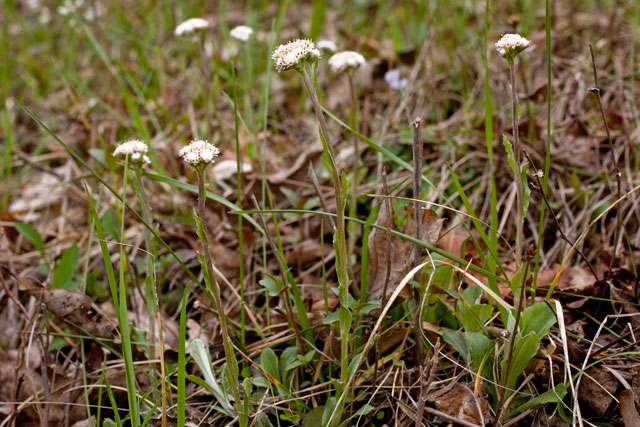 Plantain-leaved
pussytoes. April
25, 2009. Jackson County, Ohio.
Another
nice metaphor
plant growing along
the same roadside, although one whose basis isn't quite yet
evident, is colt's-foot (Tussilago farfara, family
Asteraceae).
This vaguely dandelion-like weed of disturbed ground has
horse-footprint leaves to be sure, but they aren't yet
expanded.
The "seed" heads are so bright that the fruiting plants could be
mistaken for blooming wildflowers.
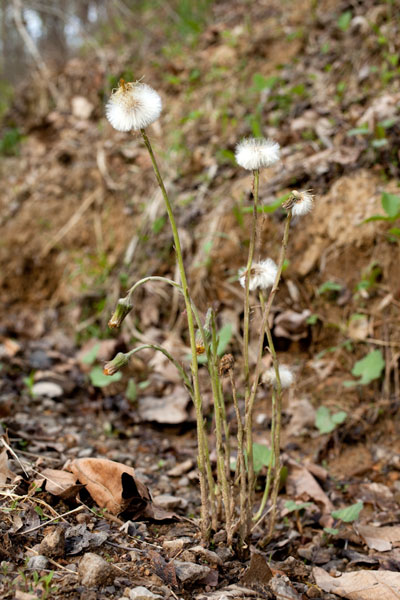 Colt's-foot fruiting. April 25, 2009. Jackson County, Ohio. Native
species of sometimes weedy genera
Most
of the time when we see a chickweed it's the little weedy
alien Stellaria media (common
chickweed, family Caryophyllaceae). Likewise, our frequently seen
vetches are introduced roadside weeds of which cow vetch (Vicia
cracca,
family Fabaceae) is an example. However, along the roadsides and the
nearby woodland edges in the wilder parts of southern
Ohio, chickweeds and vetches might warrant p'a second look. Chickweed (Stellaria) and vetch (Vicia) Jackson County, Ohio, April 25, 2009 Star chickweed (Stellaria pubera) is much more robust than our other chickweeds, and its leaves are unstalked (sessile). Chickweeds are members of the pink family, consisting of herbs with opposite leaves, and flowers that have 5 separate petals that are often cleft (sometimes deeply so, thus appearing to be 10 petals). The garden carnation, sweet-William and baby's-breath are pinks. 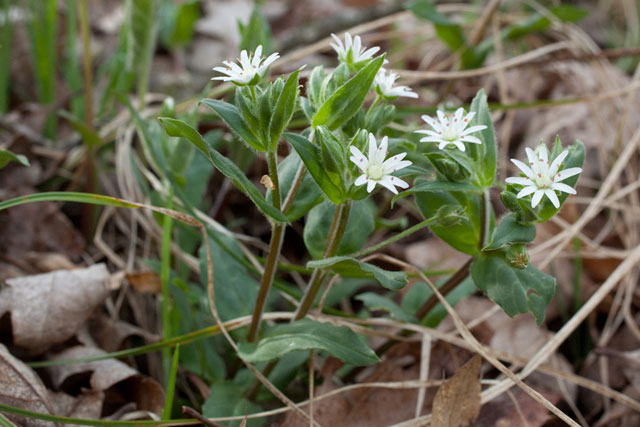 The
lovely native
star chickweed. April 25, 2009. Jackson County, Ohio
This
low-growing vine
with alternate
pinnately compund leaves ending in a pair of tendrils, and bearing
racemes of typical legume (Fabaceae) blooms looks a lot like
any
of several weedy vetch species, except that the flowers are white, not
purple. Flower color alone isn't a reliable guide, as albino plants
of many colorful species occur from time to time, but the small size of
the calyx (sepals) revealed this to be Carolina wood vetch, Vicia
caroliniana.
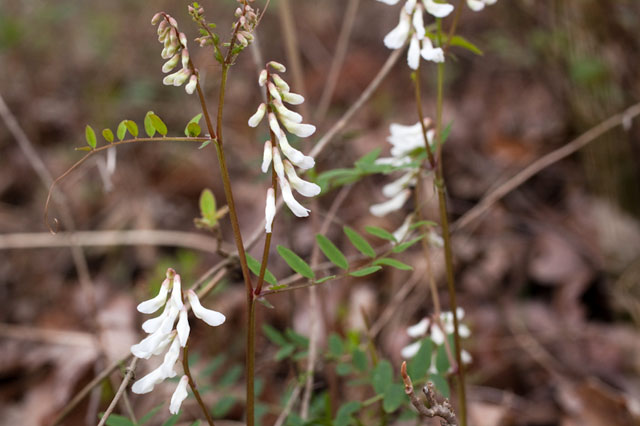 Sweetgum:
the amazing finch magnet!
Columbus, Ohio. April 21, 2009 So-called
"winter finches" are northern-breeding species in
the family
Fringillidae that are found this far south only in the winter.
There is great year-to-year variation in the numbers and kinds of
winter finches that show up in Ohio. This is generally attributed to
variation
in the cone crop up north, as they are primarily conifer seed-eaters.
Bad years for spruce, hemlock and fir seed production in
Canada equate to good years for birders here, and this past
winter was reported to be a very great one for seeing winter
finches. Reported to be. I didn't see any. Until today. In
the
city. Of all places.
Sweetgum (Liquidambar styraciflua, family Hamamelidaceae) is a lowland tree that does very well as a street tree. Not only is it beautiful, but it has the added benefit of being annoying to neighbors as it litters the ground with spiny globe-shaped "sweetgum balls." The balls are multiples of capsules containing numerous small seeds that get distributed gradually over the course of winter-early spring. Some birds love them, especially finches. The fruits are nature's version of the small-seeded thistle feeders that are popular to attract finches. Goldfinches are regular visitors to the roadside sweetgum tree in front of my house in the Clintonville neighborhood of Columbus. But it was a great durprise (surprise, whatever) arriving home to see the tree alive with approx. 2 dozen of these guys ...white-winged crossbills! People have driven hours to see white-winged crossbills. 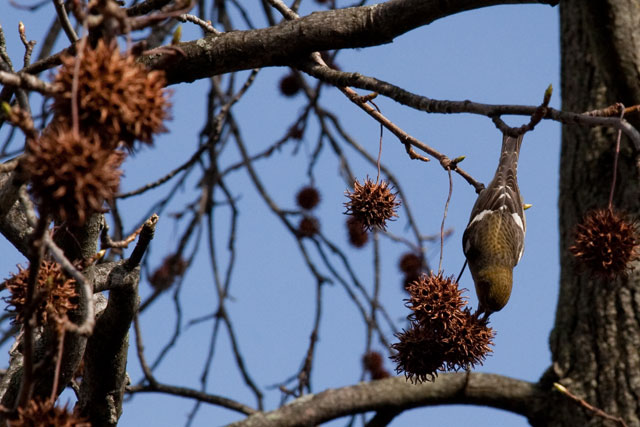 Sweetgum
tree and
white-winged crossbill. Columbus, Ohio.April 21, 2009.
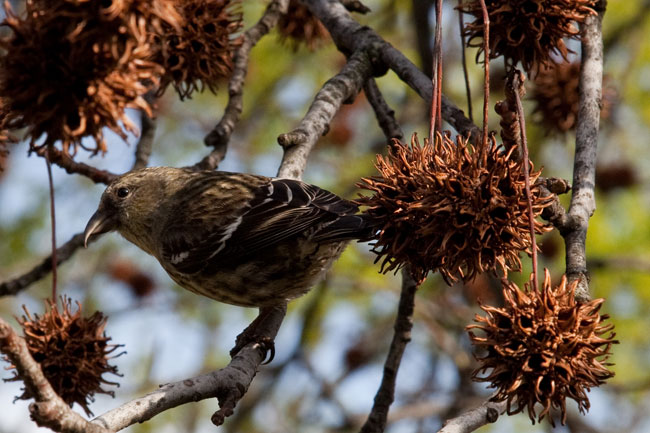 White-winged crossbill in sweetgum tree. Columbus, Ohio.April 21, 2009. Having seen this species only once, many years ago, it was necessary to consult the definitive field guide, How to tell the birds from the flowers and other woodcuts, by Robert Williams Wood (1959 Dover reprint of 1917 edition). 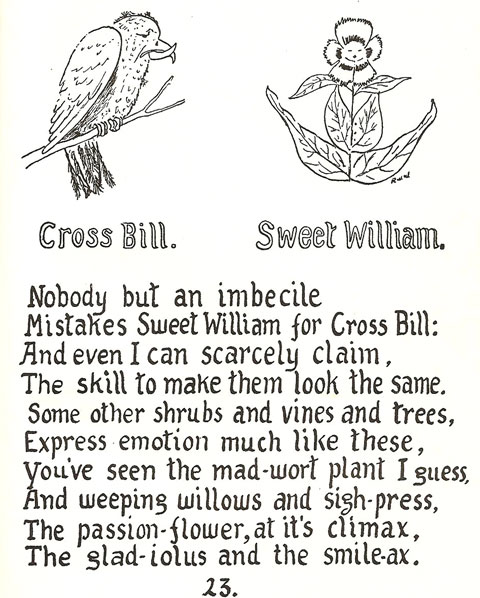 A revised manual of flornithology for beginners. Congeneric
wildflowers mix and mingle
Dicentra spp. Delaware County, Ohio. April 16-17, 2009 Two
lovely Dicentra
species (family
Fumariaceae) share the same rich woods habitat and bumblebee
pollinators. The foliage is identical too. Differentiating the
species is based on their strikingly differently shaped flowers, and,
while they both produce clusters of undergound tubers, the
tubers are about twice as large in squirrel-corn (and may be
the
basis of the common name).
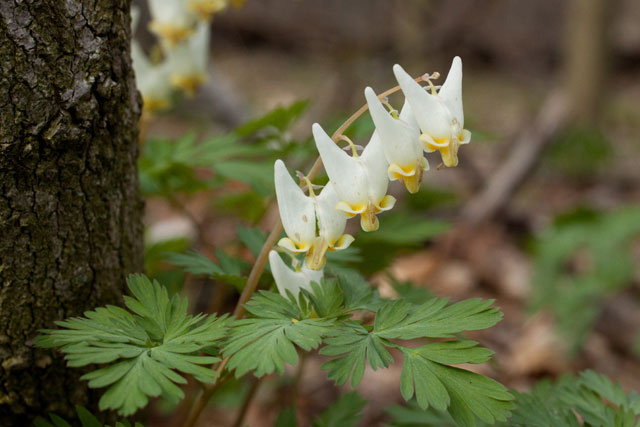 Dutchman's breeches. April 17, 2009. Delaware County, Ohio. 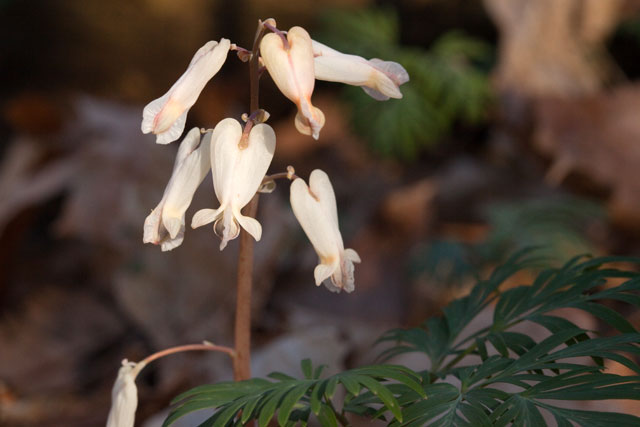 Squirrel corn. April 17, 2009. Delaware County, Ohio. With great
similarity in habitat,
pollination syndrome, and morphology, one might guess that two
co-occurring species would have different climatic tolerances, such
that that one of them is near the limits of its range. Guess
again. These Dicentra species are broadly
sympatric!
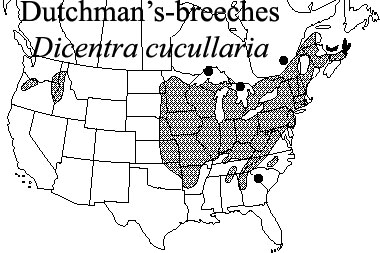 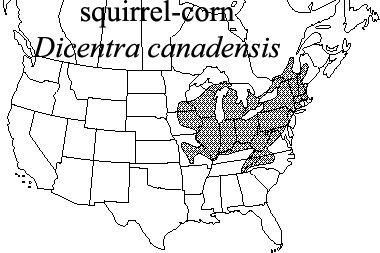 Geographic
ranges of eastern
Dicentra species. Maps from Flora
of North America.
Pollen
color dimorphism
Yellow trout-lily (Erythronium americanum) Delaware, Ohio. April 18, 2009 A
few plant species exhibit
variation, i.e., "polymorphism," in flower color. Dames's
rocket,
moth mullien, and swamp rose-mallow are familar examples. Yellow
trout-lily, Erythronium americanum (family
Liliaceae) is an interesting variation on that theme. While this
wildflower always has yellow petals (or
"tepals" as they are called in this family because the sepals
and petals are both brightly colored), there is some variation
in pollen color. One form, which seems the most
common, has dark
reddish-purple pollen. Occassionally there are strikingly
different individuals that bear bright yellow pollen. Here are two such
plants growing near one another at a woodland in Delaware County, Ohio.
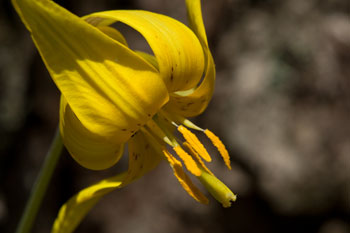 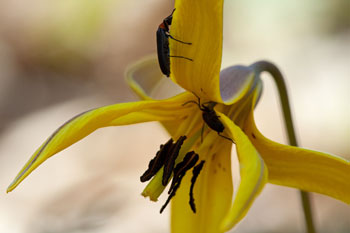 Pollen
color
dimorphism in yellow trout-lily. April 17, 2009. Delaware County, Ohio.
Polymorphism
is an
interesting aspect of
evolutionary theory. If things were simple, we would expect
that one form, more well adapted than the other, would eventually take
over the whole population as the more beneficial
gene spreads until it becomes "fixed." One general possiblity
is
that a polymorphism is maintained by "frequency-dependent
selection" wherein two forms balance one
another because the reproductive value of a trait is higher when it is
less frequent. However, it's difficult to conceive of that
being the mechanism here, as it is doubtful that pollinators
would have
a
greater tendency to visit a rare pollen color than a common
one as
long as they are rewarded for their visits. Another possibility is
"multiple niche polymorphism," wherein the different genotypes have
different fitnesses in different niches. In particular, since different
types of pollinators sometimes key in on differently colored
flowers, the two pollen color types could
constitute adaptations facilitating service by different
suites of
pollinators.
Note that in this very comprehensive study of trout-lilies, 100 percent of the purple-pollen plants were visited by beetles, while 100 percent of the yellow ones were not. With this massively big sample size of N=1 plant per pollen type, it's time to publish! Spicebush.
Delaware, Ohio. April 17-18, 2009 Spicebush
(Lindera
benzoin, family
Lauraceae, of which sassafras is also a member) is an aromatic
understory shrub that
produces abundant clusters of
small yellow flowers in early spring before the leaves emerge. The
species is dioecious. At a forest in Delaware County, Ohio, the flowers
are being visited by little midges (a type of fly). It is unclear if
they are pollinators or incidental foragers on the flowers. Below, a
staminate (male) flower cluster, with midges.
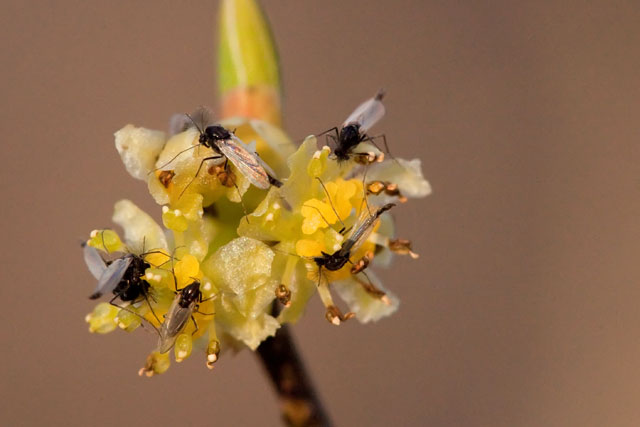 Spicebush
staminate flowers
visited by midges. April 17, 2009. Delaware, Ohio.
According
to H.A.
Gleason in the best book ever written ---- New
Britton and
Brown Illustrated Flora (1952)
-- the flowers in this family are regular and hypogynous, with a
perianth (usually termed a calyx) of 4 or usually 6 separate segments
in two whorls. For Lindera, we
learn the calyx is
6-parted, deciduous; stamens 9, the inner bearing
glands at base; anthers introrse,
2-celled, opening by 2 minute uplifted valves.
Below is an enlarged view of the staminate flower. MOUSEOVER
the image
to see parts labelled.
Spicebush
staminate flower. Note two-celled "introrse"
(inward-facing) anthers
that open
by minute uplifted valves, and 3 glands in center of flower The
pistillate (female)
flowers have
reduced male parts termed "staminoidia" that are barely evident in the
picture
below. Note the plump ovary in the center of each flower, and the
elongate style extending upwards.
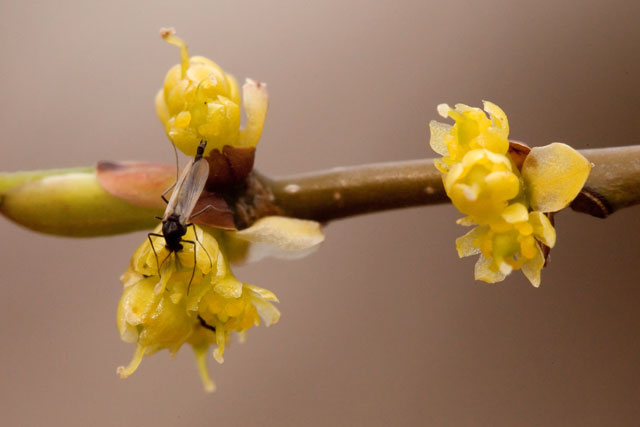 Spicebush
pistillate flowers.
Delaware County, Ohio. April 18, 2009.
Midges
avidly visit the
spicebush while spring peepers (Hyla crucifer)
peep.
Midges
avidly visit spicebush. Delaware County, Ohio. April 18, 2009.
Mosses
on a wall.
Orthotrichum pusillum and Tortula papillosa Columbus, Ohio. April 11-15, 2009. In
the Clintonville
neighborhood of
Columbus there is a home with a little brick wall separating the front
yard from the sidewalk. The wall is situated a short distance from a
venerable old sugar maple adorned with mosses. The
tree is
probably the source population for the mosses on the wall, as they
are normally regarded as corticolous (bark-inhabiting) species.
Occurence on a wall like this is by no means unusual however.
 Brick wall habitat of mosses. April 15, 2009. Two
species of mosses
occur here. Both are
acrocarps, i.e., "cushion mosses" that consist of separate
erect stems which, if they bear sporophytes, bear them at the apex of
their stems. The most abundant moss on the wall does in fact produce
sporophytes,
abundantly. Spores are part of a sexual life cycle. They are
produced
by the the reductive cell division process called
"meiosis" that
is necessary for the union of equal amounts of genetic
material to take place at some other stage in the life cycle. Just
after a recent rain, the moss Orthotrichum pusillum
(family Orthotrichaceae) displayed its newly opened spore cases
(sporangia, also called "capsules").
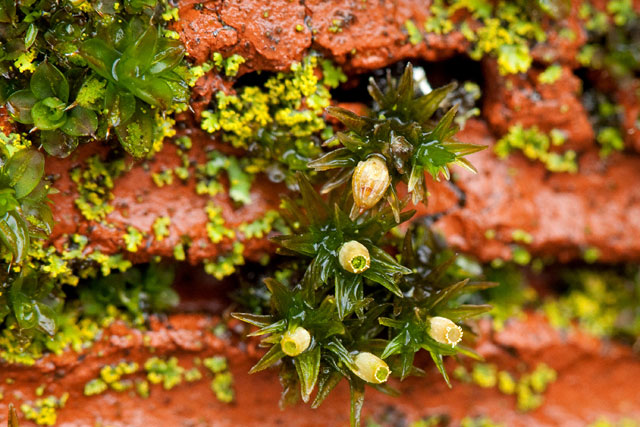 Orthotrichum pusillum moss with newly opened spore capsules. April 14, 2009. Columbus, Ohio. Occurring alongside the Orthitrichum (a few plants are visible in the upper left region of the its photo) is a moss that reproduces asexually --Tortula papillosa (family Pottiaceae). It has broad leaves, many of which are partly covered with few-celled gemmae produced along the costa (midvein), each of which can potentially generate a whole new plant that is genetically identical to the one that produced it. 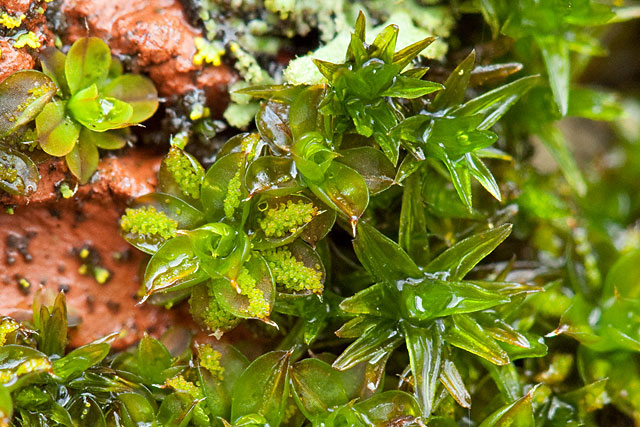 Tortula papillosa moss producing few-celled gemmae. April 12, 2009. Columbus, Ohio Congeneric
wildflowers mix and mingle
Erythronium spp. Worthington, Ohio. April 12, 2009 According
to the the ecological "competitive
exclusion principle," species with identical resource requirements
(niches) cannot long persist in the same place because one species will
eventually out-compete the other for critical resources. Thus, when we
see closely related species together, it
raises the question "how are they different ecologically?"
The two
trout-lilies --yellow flowered Erthronium americanum
and white flowered E. albidum
(family Liliaceae) --are a case in point. Possibly they have different
pollinators, since the function of the (differently colored) petals is
to attract
pollinators. They are found alongside one another flanking a wooded
bike trail in Worthington,
Ohio.
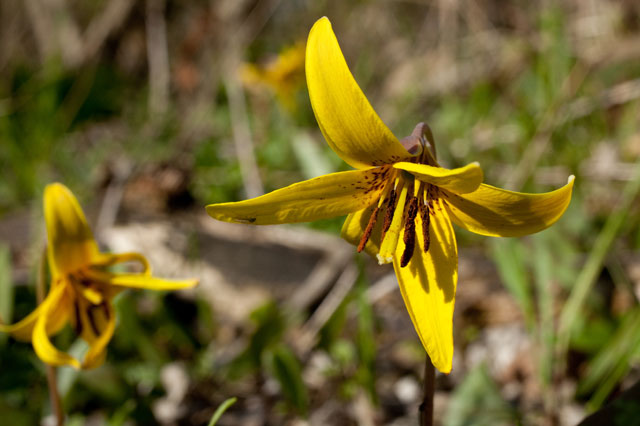 Yellow trout-lily. April 12, 2009. Worthington, Ohio. 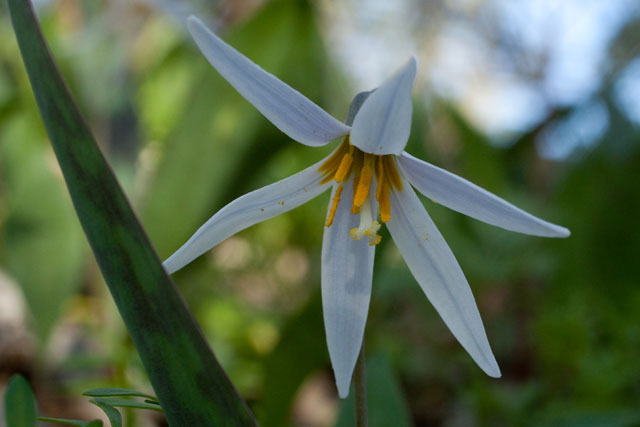 White
trout-lily. April 12,
2009. Worthington, Ohio
Flower
color is often
an easy way to
distinguish related species, but there are generally other,
more technical,
differences as well. With these trout lilies, the stigmas
(uppermost, pollen-receptive, portion of the female pistil) are
differently shaped. The stigmas of E. americanum
are pressed together, whereas those of E. albidum
are separate and outwardly curved.
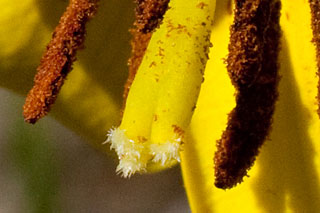 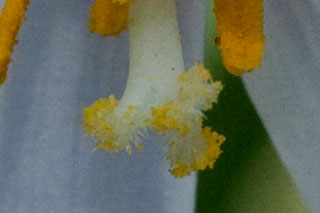 Trout-lily
(Erythronium)
stigmas. Left: E. americanum. Right: E.
albidum.
They
have different geographic ranges, too. E. Lucy Braun in The
Monocotyledons of Ohio (Ohio
State University Press, 1967), explains that white trout-lily is "a
species of the
interior, ranging from southern Ontario and Minnesota southward to
Kentucy, Georgia, Missouri and Oklahoma; rare eastward to Pa.
and
D.C.; widespread in Ohio in mesic or dry woods, and sometimes so
abundant as to whiten whole hillsides." Yellow trout-lily
extends
"much farther eastward, through New England to Nova Scotia, widely
distributed in Ohio where it is the commoner species on the
northeastern counties."
Twin-leaf
is locally
abundant in calcareous soil of the
wooded banks overlooking the Scioto River in Columbus. These pictures
were taken at Duranceaux Park, located on the west side of the river
south of Fishinger Road. The park is the proposed site of a
controversial boathouse planned for the OSU women's varsity rowing team
and a private rowing club. Opposition
to the plan is intense.
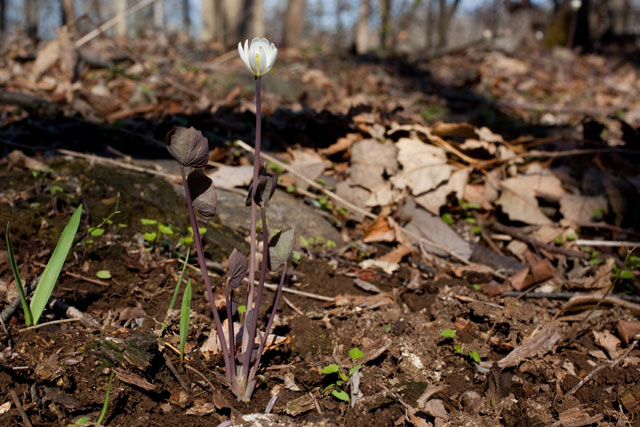 Twin-leaf. April 11, 2009. Duranceaux Park, Columbus, Ohio. Twin-leaf
is a spring
wildlflower in the
barberry family, Berberidaceae, a family that is closely related to the
buttercups (Ranunculaceae) from they
are distinguished by
having 1 pistil (rather than several-many
pistils), stamens as many or twice as many as the petals
(rather
than
being numerous) and petals arranged in a circle (as opposed to being
spirally arranged). According to
H.A. Gleason in the best book ever written -- New Britton and
Brown Illustrated Flora
(1952) -- "Our herbaceous species are interesting survivors of an
ancient Tertiary flora." Other such members of the family are Podophyllum
(May-apple) and Caulophyllum (blue cohosh).
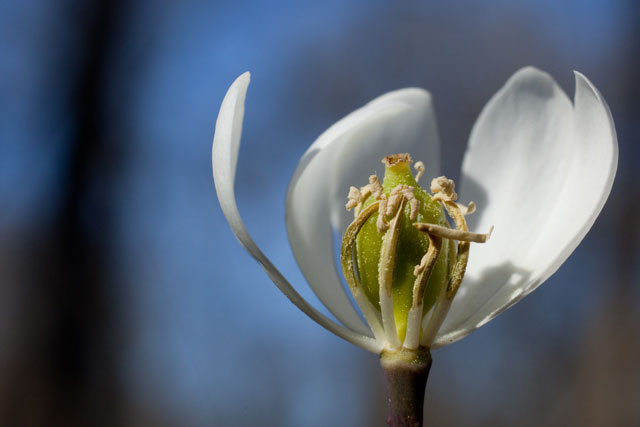 Twin-leaf flower. April 11, 2009. Duranceaux Park, Columbus, Ohio. The twin-leaf ovary is ovoid, many-ovuled, and tapers to a broad sessile stigma. The fruit is a many-seeded obovoid capsule that opens in the upper half by a horizontal cleft extending halfway around it, the top forming a lid. Last year I made a frustrating excursion to this spot to see twin-leaf in flower, but a few weeks late. The leaves and young fruits were quite evident, however. 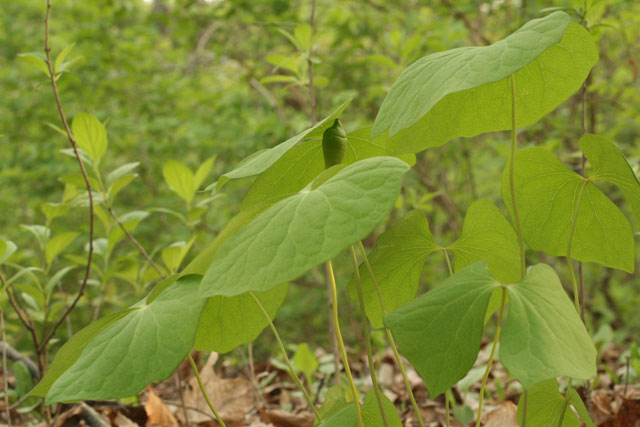 Twin-leaf
as it will
appear in a few weeks. May 1, 2008. Columbus, Ohio.
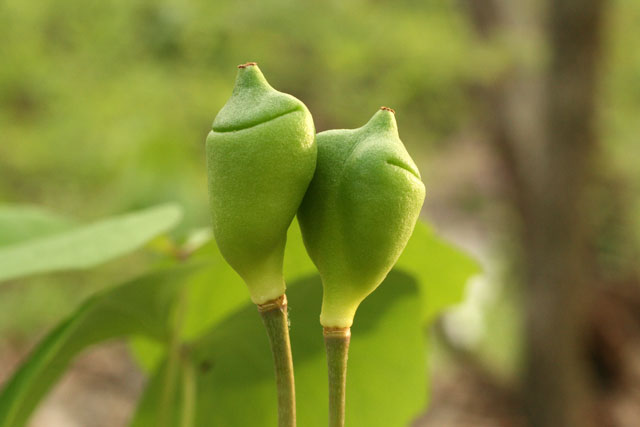 A
twin-leaf
capsules opens in the
distal half by a longitudinal
cleft extending halfway around it. Whitlow-"grass"
Erophila (Draba) verna Marion, Ohio. April 9, 2009 Whitlow-grass
is not a
grass, but a wee
little mustard (family Brassicaceae). The plant, a native of Europe, is
often described as "naturalized." That seems to mean that is is well
established but not in any obtrusively invasive manner. Because the
plants are very small and grow in open barren places such
as sidewalk cracks, or between flagstone bricks as
shown
here, they don't displace any other plants. They look like little
people though. Stick-figures. Dancing. The fruits (silicles) are the
hands and feet.
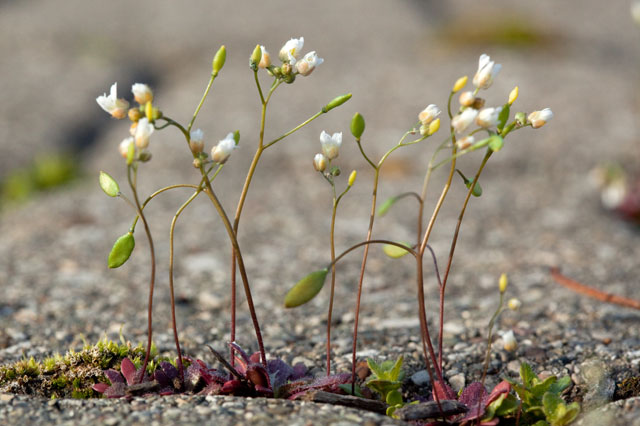 Whitlow-grass.
April 9, 2009.
OSU at Marion, Ohio.
Whitlow-grass
has a
fairly unusual life span. It is a "winter annual,"
overwintering not as a seed as do most annual plants, but instead as a
flat little rosette of leaves. Immediately in early spring one
or
a few flowering scapes extend from the
rosette, self-pollinate, develop fruit,
and finally as the plants die the seeds fall.
The seeds soon germinate and, by the end of summer,
will have grown into the next generation of over-wintering
rosettes.
Callery
Gallery!
Callery pear/Bradford pear Worthington, Ohio, April 5, 2009. Suddenly
the urban
roadsides are lit up
with brilliant mass flowering displays of a very
popular/unpopular
tree. Bradford pear, a cultivated variety of Callery
pear, Pyrus calleryana
(family Rosaceae), is an Asian native that was brought over to a
nursery in Massachusetts 101 years ago. It is widely used in
landscaping yards, roadsides, parking lots., etc., hence by definition
it is popular.
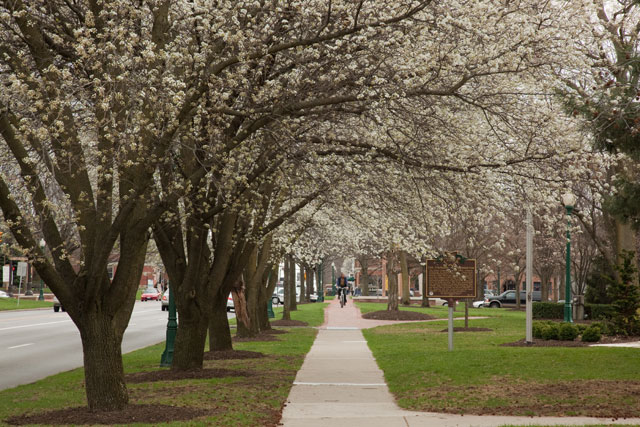 Callery
(Bradford)
pear trees. April 5, 2009. Worthington Ohio.
But other than admiring its current short-lived prettiness, nobody seems to have much nice to say about Bradford pear. The trees are notoriously brittle and easily wind-blown, thus wreaking havoc on nearby utility lines. Worse, the species is invasive, spreading into open woodlands, competing with the native plants. 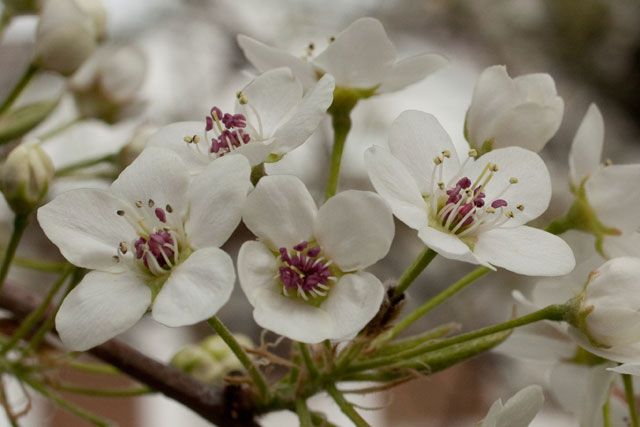 Callery
(Bradford)
pears trees. April 5, 2009. Worthington Ohio.
Worthington is a nice place, but the city generates too much of its revenue issuing speeding tickets to careful safe drivers travelling only slightly above inconspicuosly posted, ridiculously low speed limits. Avoid the place. Grrr. An
anomalous and weedy buttercup.
Lesser celandine (Ranunculus ficaria) Columbus, Ohio April 5, 2009. Many
buttercups, i.e., members of the genus Ranunculus
(family Ranunculaceae), are
also called "crowfoots"
because they bear palmately compound leaves
that evidently reminded somebody of the terminal portion of a corvid's
leg upon which it stands. But it is the totality of
characters that help reveal a plant's taxonomic affinity. One or two
exceptional features don't rule them out. There is an
interesting simple-leaved-with-entire-margins buttercup that
is
quite the weed in some moist open woods of central Ohio. This is Ranunculus
ficaria (lesser
celandine, also called "fig buttercup"). It is an aggressive
ground-hugging alien that reproduces sexually, and also
asexually by
means of tubers and bulblets, crowding out native spring wildflowers.
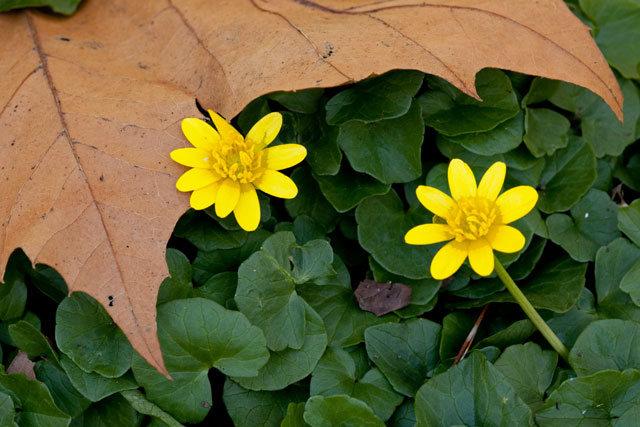 Lesser celandine and a sycamore leaf. Delawanda Park, Columbus, Ohio. April 5, 2009. The nasty little plant bears a superficial resemblance, in flattened miniature, to a beloved native wildflower also in the buttercup family --cowslip or marsh "marigold," Caltha palustris. Here's a picture of cowslip, taken a few years ago. 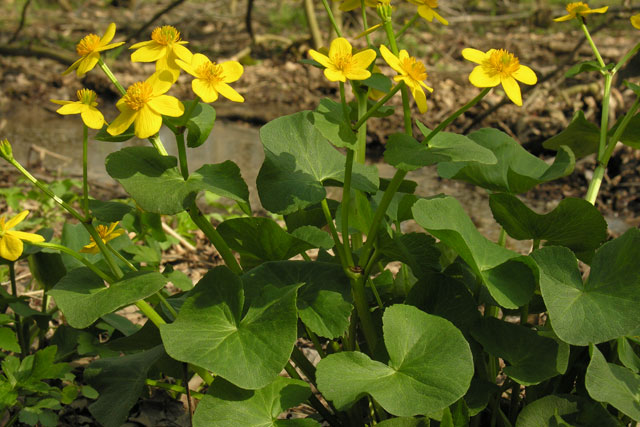 Cowslip at Myer's Woods Preserve, Marion County, Ohio. April 21, 2005. |

